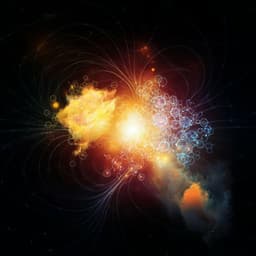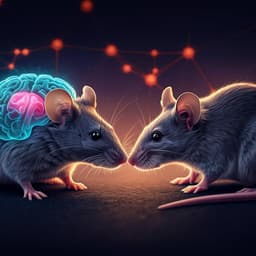
Medicine and Health
Ripple-locked coactivity of stimulus-specific neurons and human associative memory
L. Kunz, B. P. Staresina, et al.
Dive into the fascinating world of associative memory with cutting-edge research conducted by Lukas Kunz and colleagues. This study reveals how object-specific and place-specific neurons work together in the medial temporal lobe, showcasing the intricate dynamics of neuronal activations during memory tasks. Uncover the flexibility of neuron-ripple interactions as demonstrated through single-neuron recordings from epilepsy patients!
~3 min • Beginner • English
Introduction
Associative memory links previously unrelated stimuli and relies on the hippocampus and neighboring medial temporal lobe (MTL) regions. The authors investigated whether separate populations of stimulus-specific neurons—object-responsive and place-responsive cells—are transiently bound during encoding and retrieval via hippocampal ripples, high-frequency oscillations thought to synchronize activity across brain regions. They hypothesized that ripple-locked coactivity between object and place cells supports the formation (via synaptic plasticity) and retrieval (via reactivation of established links) of object–location associations, and that the timing of such coactivity may differ between encoding and retrieval.
Literature Review
Prior work has implicated hippocampal ripples in human memory encoding, retrieval, and consolidation, with ripple rates modulated by cognitive state. In rodents, ripple-associated place-cell sequences reflect meaningful spatial trajectories and support learning and planning. Human and animal studies have also shown long-range synchronization of ripples across brain regions and coupling to low-frequency oscillations. While conjunctive coding (neurons responding to specific stimulus combinations) has been observed, it remained unclear whether ripples temporally bind functionally distinct neuronal populations (e.g., object and place cells) to form associative memories. This study addresses that gap by testing the coactivity (vs conjunctive-only accounts) of stimulus-specific neurons during ripples.
Methodology
Participants were 30 epilepsy patients (41 sessions with intracranial EEG; in 27 sessions from 20 patients, single-neuron microelectrode recordings were also obtained). Patients performed an associative object–location memory task in a landmark-free virtual arena: initial encoding of eight object locations, then repeated test trials comprising ITI, cue (object image), retrieval (navigate to remembered location), feedback, and re-encoding (object appears at true location). Behavioral performance was quantified by distance error transformed to performance values accounting for positional geometry.
Neurophysiology: Macroelectrode LFPs (2 kHz) from bipolar hippocampal contacts (mostly anterior hippocampus) were used to detect ripples (80–140 Hz) with stringent criteria: removal of interictal epileptiform discharges (IEDs), exclusion of global artifacts, amplitude and duration thresholds (≥20 ms and ≤500 ms), ≥3 cycles, and a power-spectrum global peak in the ripple band. A total of 35,948 ripples were detected. Ripple phase-locking to low-frequency (0.5–2 Hz) delta phase was assessed. Extra-hippocampal MTL ripples (temporal pole, amygdala, entorhinal and parahippocampal cortex) were detected similarly; cross-correlations with hippocampal ripples assessed interregional coupling.
Single-unit recordings (30 kHz) from MTL microelectrodes were spike-sorted (Wave_Clus), yielding 1,063 neurons across regions. Object cells were identified by increased firing to a single preferred object during the cue (permutation tests and time-resolved cluster-based statistics). Place cells were identified by spatial firing fields in the virtual environment (rate maps on a 25×25 grid, thresholding, surrogate testing via circular shift). Conjunctive object–place cells (spatial tuning only for one specific object) were also assessed.
Coactivity analysis: For simultaneously recorded object–place pairs and a ripple channel, binary activity within sliding 100-ms windows around ripple peaks (−0.25 to +0.25 s for main maps; extended windows for activity detection) was used to compute a coactivity z-score across ripples. Two-dimensional time-by-time coactivity maps quantified how often both neurons were active during the same ripples while controlling for their base rates. Analyses were performed separately for retrieval and re-encoding periods, and for early vs late ripples (first vs last half of session). Statistical evaluation used cluster-based permutation tests across pairs, comparing against zero (chance), against baseline (windows away from ripples), and against non-associative pairs (preferred object located outside the place field for that trial condition). Additional analyses examined ripple-related LFP power changes across MTL, ripple-locked firing rate changes, movement vs non-movement states, and timing relative to initial memory formation.
Key Findings
- Hippocampal ripples showed delta phase preference around 34° (Rayleigh test: z=5.614, P=0.003), and were associated with MTL-wide state changes: increased high-frequency (>20 Hz) LFP power and decreased low-frequency power in extra-hippocampal MTL regions (ipsilateral P=0.018 increase; contralateral P<0.001 increase; decreases P<0.001), and elevated single-neuron firing rates peaking near ripple times (P<0.001).
- Ripple rates varied by trial phase (repeated-measures ANOVA P<0.001): increased during cue versus other phases and reduced during retrieval, feedback, and re-encoding relative to ITI; ripple duration showed a similar pattern (P=0.046), frequency was not modulated (P=0.690).
- Ripple–behavior relationships: Higher ripple rates during cue predicted better subsequent retrieval performance (Bonferroni-corrected P=0.038). Poorer retrieval performance was followed by higher ripple rates during re-encoding (P<0.001). Ripple rates during feedback decreased over time (P=0.012).
- Identified 120 object cells (11% of neurons; P<0.001), most prevalent in entorhinal cortex, parahippocampal cortex, and temporal pole; tuning peaked within 1 s after cue onset and was stable. Most object cells were not place cells (81%).
- Identified 109 place cells (10%; P<0.001) in entorhinal cortex, hippocampus, and parahippocampal cortex; place fields spanned the environment, with ~20% higher firing inside vs outside fields and stable maps.
- Coactivity during retrieval: Associative object–place pairs (preferred object’s response location within the place field) showed ripple-locked coactivity across all retrieval ripples vs chance and vs non-associative controls (both P<0.001), though not vs baseline (P=0.178). When restricted to late ripples, coactivity was robust: vs chance P=0.004, vs baseline P=0.004, vs non-associative P=0.006 (Bonferroni-corrected). Early ripples showed weaker or non-significant effects.
- Coactivity during re-encoding: Across all ripples, significant vs chance (P<0.001) and vs non-associative (P<0.001), but not vs baseline (P=0.064). For late ripples, effects were robust on all tests: vs chance P<0.001, vs baseline P=0.040, vs non-associative P<0.001 (Bonferroni-corrected). No significant effects for early ripples.
- Timing differences: During retrieval, object–place coactivity peaked at or shortly after ripple peaks (object earlier, place slightly later). During re-encoding, coactivity tended to precede ripple peaks, indicating a shift in timing between behavioral states.
- Coactivity predominated during non-movement ripples, aligning with rodent findings on immobility-related ripples. Coactivity patterns before vs after initial memory formation paralleled early vs late ripple distinctions.
Discussion
Findings support the coactivity hypothesis of associative memory: distinct populations of object- and place-tuned neurons coactivate during hippocampal ripples when humans retrieve or re-encode object–location associations. Coactivity was specific to associative pairs and emerged over time, suggesting strengthening of synaptic links with learning. Ripple events coordinated widespread MTL excitability and interregional coupling, providing temporal windows for binding. The timing of coactivity relative to ripple peaks shifted between retrieval (after ripples; hippocampus-to-cortex propagation) and re-encoding (before ripples; potential cortex-to-hippocampus influence), indicating flexible interactions dependent on behavioral demands. These results complement conjunctive coding accounts, suggesting coactivity may contribute to or give rise to conjunctive representations in downstream neurons. More broadly, ripple-locked coactivity may enable transient integration across diverse content dimensions (e.g., items, places, time) in episodic memory and planning.
Conclusion
The study demonstrates that hippocampal ripples are linked to coordinated coactivity of stimulus-specific neurons in the human MTL during associative memory retrieval and re-encoding. Object and place cells activate together during ripples specifically when they represent the components of the association, with coactivity strengthening later in learning and showing state-dependent timing. Ripples also induce MTL-wide excitability and interregional coupling. These findings provide a cellular mechanism for binding separate memory elements and highlight ripples as temporal organizers of associative memory. Future work should employ causal manipulations of ripple-locked coactivity, disambiguate ripple subtypes and their relation to gamma-like events, compare anterior vs posterior hippocampal contributions, and probe neuromodulatory influences. Clinical avenues include exploring ripple augmentation to support memory in disorders.
Limitations
Causality is unresolved: ripple-locked coactivity may reflect downstream effects of broader modulatory processes (e.g., neurotransmitter-driven increases in excitability) rather than directly inducing synaptic changes. It is unclear whether coactivity reflects direct synaptic connectivity between object and place cells or coordinated input from upstream regions. Coactivity was quantified in 100-ms windows, broader than classic spike-timing-dependent plasticity windows; how such timescales map onto human plasticity remains open, though humans may exhibit wider STDP windows and other forms of plasticity (e.g., behavioral time-scale synaptic plasticity). Recordings sampled primarily the anterior hippocampus, limiting generalization across the longitudinal axis. There is ongoing debate about whether detected high-frequency events represent true human ripples versus broadband or high-gamma activity; although stringent detection criteria were applied, misclassification could affect interpretation.
Related Publications
Explore these studies to deepen your understanding of the subject.







